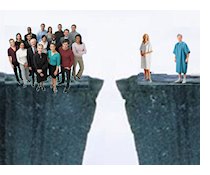 (Note: June 2016 – this post is now more than 3 years old. See an update below.)
(Note: June 2016 – this post is now more than 3 years old. See an update below.)
In the category of “life imitates career”….
In 8+ years of blogging, and with the exception of the personal experience that was the impetus for my career as Every Patient’s Advocate, (later the founder of AdvoConnection and the Alliance of Professional Health Advocates), I have rarely (if ever?) shared my personal medical experiences. Truth is, until now, they have been, thankfully, quite boring and not worth writing about.
Yes, until now… because now, “the lump” has returned.
Lump #1, discovered, excised, misdiagnosed as cancer, yet never treated in 2004, is the personal experience I mentioned above. (If interested, here’s the entire story). It was such a heinous and outrageous odyssey, it caused me to change careers to patient empowerment in an effort to do what I can to ensure that others would not suffer such a horrible experience.
Of note is that Lump #1 was never accurately diagnosed. So, to this day, I have no idea what caused that original lump.
And then…
Two weeks ago, a second lump appeared – 9 YEARS after the first one. Very odd. So I’ve begun the journey to a diagnosis for this lump.
So far, with the exception of the lump’s location on my body, Lump #2 seems physically the same as Lump #1. It’s about the same size (like a golf-ball), it’s the same hardness, by itself it does not hurt. As I go to the doctor, I would describe it exactly the same way as I described it those years ago.
But everything else – EVERY OTHER ASPECT OF THIS SECOND JOURNEY – is entirely different.
Why?
Because I am in charge of what happens.
This time around, I am empowered and emboldened.
I am the one making the decisions. I am approaching the medical professionals as resources – not Gods. I have researched the possibilities, I have pulled together my old records (ensuring the same mistakes won’t be made again!), and I am making sure that each next step is considered by weighing the possibilities against what makes sense.
In 2004, the experience was so overwhelming and frightening, that I still occasionally suffer from post-traumatic stress (PTSD.)
In 2013, I have peace-of-mind. I’m not even losing sleep over it.
So why write about it at all? To encourage you, as a patient advocate, to understand that YOU can be the force that makes that leap for your clients between fear of the unknown – and peace-of-mind. Between suffering at the hands of the healthcare system – and finding their best outcomes.
Not all patients understand empowerment, and, frankly, the nature of human beings is that they don’t really care much about being empowered, understanding the system, or figuring out how to navigate it — until they are faced with something drastic.
That means that, the day “drastic” becomes reality, they are forced to pay attention (when odd symptoms appear, or they are given a scary diagnosis), and they aren’t prepared. They have no idea what to do next. They are lost and frightened – a dangerous combination. Further, because they are scared, and probably sick, and mentally fatigued from this new reality, they can’t ramp up to learn to be empowered themselves.
Enter you – the patient advocate.
YOU can be the reason your clients won’t lose sleep due to fear of the unknown. YOU can provide the support needed to give them confidence that their decisions are being made on accurate, and complete information. YOU can bridge the gap between random and frightening interface with the system, and care coordination that produces absolutely the best outcomes for your client, resulting in the peace-of-mind that results from empowered decision-making.
My advice today is about helping you see your work in this light – even explaining it to clients and potential clients in exactly this same way. All clients crave peace-of-mind. All clients can understand Point A – their fear of the unknown, not knowing what to do next. And all clients understand Point B – where they prefer to be – the idea of being confident, in control, and sleeping like a baby.
To the extent you position yourself as the gap-filler who provides that peace-of-mind, who gets them from Point A to Point B, they will rush to hire you. Focus your marketing efforts on that point of view – through one-on-one (word of mouth) conversations, public speaking efforts, even on your website or in your brochures.
I cannot fully explain to you the difference in my mental and emotional status between Lump #1 and Lump #2. It is, truly, a world of difference.
Tap into that “world of difference” for your clients and potential clients. Fill the gap; provide them with peace-of-mind. It will help you find your success.
(Update June 2016: To bring closure to this story…. a visit to my primary care doctor resulted very differently from the first time around. The first time in 2004 I was immediately sent to a surgeon – and the rest is history. This time, in 2013, I insisted on trying to treat it with something that might make it just disappear instead – an antibiotic. Three weeks later it was gone. Then another lump appeared in 2014 and – no treatment whatsoever – it simply disappeared on its own. Now fast forward to today – no more lumps. And, frustratingly, still no diagnosis. A medical enigma.)
? ? ? ? ? ? LEARN MORE ? ? ? ? ? ?
FOR PATIENTS | FOR ADVOCATES | FOR POTENTIAL ADVOCATES
? ? ? ? ? ? ? ? ? ? ? ?





Best wishes to you Trisha. I went through uterine cancer surgery in 2011, and I was a lot like you. I went into it empowered with knowledge. I researched the quality ratings and asked for infection rates for the 3 hospitals and different surgeons I was considering. My GYN/ONC consultation visit lasted 2 hours. And finally I wrote letter to my healthcare team at my chosen hospital and laid out my expectations of patient centeredness and safety for my care. I was still scared…that is natural with a dx of cancer I think….but I did feel like I held the reigns of my own care. I would advise anyone to do the same.
My surgery was done, with absolutely no complications. I didn’t need any follow up cancer treatment, but I do get rechecked every 6 months for a total of 5 years. My experience was stellar!